Greetings Everybody,
During the weekend between our second and third week in Siena, Italy, we said goodbye to Professor Alan Pratt and his wife, Bonnie. Then we had pizza with our second Embry Riddle Professor, Robert Fleck and his wife. This professor swap is due to the structure of the Siena study abroad program. One of our classes, HU 399 Italian Art & Culture, focuses on Italian contribution to both art and science. Professor Pratt is a humanities professor and so taught us about art. We studied the Renaissance, High Renaissance, and Baroque periods. Professor Fleck is a physics professor, so he focused on science. With Dr. Fleck we learned about linear perspective, geometry, and astronomy.
Our third week went pretty much like the two previous, with one exception. Instead of visiting Venice, we visited Florence. We had to wake up early on a Thursday morning and catch a bus to the train station. From there, we took a high speed train to Florence. The high speed trains were very comfortable. We had ample room for our luggage and the seats had a lot of leg space. Even though we only spent a day in Florence, we saw many buildings and artifacts that are important to religion, art, and science.

The first building we visited in Florence was Basilica of Santa Maria Novella. Located near the train station, the basilica is the city’s most important Dominican church.
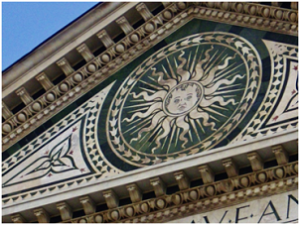
The solar emblem, found on the pediment, is a sign of the Dominican order. The lower part of the façade is gothic while the top part contains elements of humanist architecture, which mixes classical architecture with proportion and astronomy. This can be seen in the Corinthian columns that surround the entrance and the geometry of the rectangles, squares, and circles on the building. Evidence of the importance of science to religion can also be found on the façade.
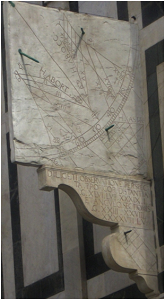 In the past, people used this decoration as a tool to tell then when important seasons and holidays were occuring based on the location of the shadows cast by the pins on the chart. In additon, Basilica of Santa Maria Novella is the first church to have volutes, or scrolls, located on either side of the pediment. These s-shaped decorations can be found on churches all over Italy and later were an important feature of Baroque architecture.
In the past, people used this decoration as a tool to tell then when important seasons and holidays were occuring based on the location of the shadows cast by the pins on the chart. In additon, Basilica of Santa Maria Novella is the first church to have volutes, or scrolls, located on either side of the pediment. These s-shaped decorations can be found on churches all over Italy and later were an important feature of Baroque architecture.
Inside the basilica, is a fresco by an early Renaissance painter named Masaccio. The Holy Trinity is one of the first works of art that correctly implemented linear perspective, a mathematical concept. Using this technique, Masaccio was able to create the illusion of depth in the fresco by using a common vanishing point. Therefore, it appears that God is behind Jesus with a dove, who symbolizes the holy spirit, between them. In addition, the panels of the barrel vault in the background appear to getting smaller as they progress into the work. It was really incredible, unfortunately they did not allow photographs so I don’t have one here.
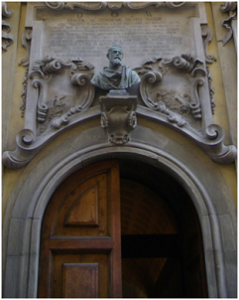 While we walked around Florence, we saw multiple busts of Galileo.
While we walked around Florence, we saw multiple busts of Galileo.
Galileo Galilei was a physicist, mathematician, astronomer, and philosopher. He was known for his role in the Scientific Revolution. He improved the telescope, discovered Jupiter’s four largest moons, and was the first to observe the phases of Venus. Galileo also analyzed sun spots and supported Copernicus’ heliocentric theory. For his beliefs, he was inspected by the Inquisition and deemed guilty of heresy. For the rest of his life he was under house arrest and forced to recant heliocentric theory.
Our 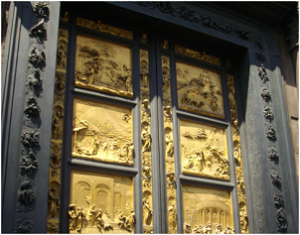 next destination was Lorenzo Ghiberti’s Gates of Paradise.
next destination was Lorenzo Ghiberti’s Gates of Paradise.
In 1400, the guild responsible for the Baptistery’s maintenance decided to sponsor an artistic competition in which the victor would be awarded the commission to create new doors for the building. Ghiberti won the contest and provided a series of ten bronze reliefs depicting scenes from t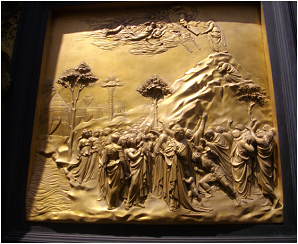 he Old Testament.
he Old Testament.
In these panels, Ghiberti has created the illusion of depth by making the figures in the foreground of the image three dimensional and flattening ones in the background. The bronze reliefs of the Gates of Paradise were cast mostly as one piece except for a few of the elements. Ghiberti’s technique was less labor-intensive and used less materials that his competitors.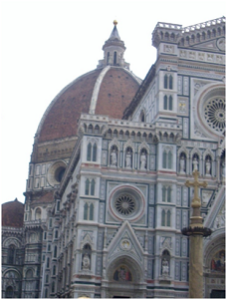
Across the street from the Gates of Paradise is the Cathedral, Santa Maria del Fiore.
Finished in 1434, the dome of the building was devised and built by Filippo Brunelleschi. Instead of being a hemisphere, like other cupolas before it, Brunelleschi designed the roof to be parabolic. This maximized the height of the ceiling. The dome was constructed without the use of Gothic buttresses and relied on a double shell design. Today, visitors can still climb stairs between the two layers to reach the top of the dome.
The longest we spent visiting one particular attraction in Florence was two hours. Around midday, we entered the Uffizi Museum.
attraction in Florence was two hours. Around midday, we entered the Uffizi Museum.
Outside the museum, there were statues of the great artists who are featured inside. The Uffizi palace was commissioned by the Medici family in 1560 and was used as offices for various magistrates. Over time, the Medici family used the building to display their art collections. After the last family member died, the palace was turned into an art gallery that grew into a museum.
While I was at the museum, I made sure to follow around our professor, Dr. Fleck. Even though he has a doctorate in physics, he knows a lot about art. We visited almost every room in the museum. I remember that we visited a gallery on the Dutch Golden Age. We examined works by Rembrandt, who was one of the most important artists of that time period. The Dutch fascination with light was exemplified in their works. Paintings of wine glasses reflected and distorted light exactly like a real glass would. Pictures of people and fruit were bright with light from clearly defined sources. It was truly amazing.
The nice part of this week was that we visited Florence on a Thursday, leaving the rest of the weekend for us to do as we pleased. Some of my peers would take the opportunity to travel around Italy and visit other cities. They would visit Sicily, Milan, Cinque Terre, etc. Sometimes, their weekend excursions would go very well and they would have a lot of fun. Other weekends were a bit stressful due to long commutes or problems with hotels. Usually on the weekends, I would head back to Siena so I could explore the city on my own. I would purchase gifts for friends and family back home, possibly do some laundry, and work on arranging a visit to the Borghese Gallery in Rome. I needed to go there to see some of Gian Lorenzo Bernini’s most famous works, one of which I would base my honors contract paper on.
As always, thank you for reading.


